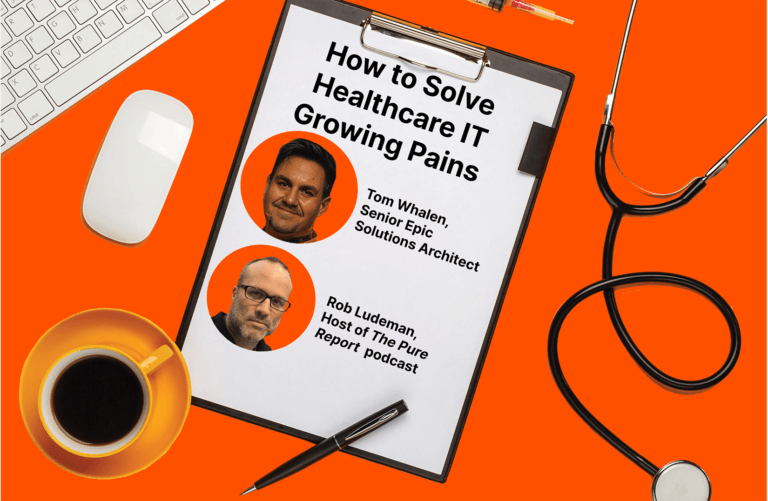Data is the lifeblood of healthcare, and yet organizations fall along a spectrum of how effectively they’re managing and using that data. Wherever an organization is in its digital transformation journey, one thing is certain: Healthcare data has to be protected, accessible, and agile.
Here are five predictions of how data will transform healthcare.
1. Cyberattacks will remain a healthcare security and compliance threat.
According to a survey by Black Book Research, 73% of healthcare organizations have been hit by ransomware—and 86% of healthcare IT leaders believe attackers are outpacing their enterprises. Healthcare IT must continue to take measures to stay on top of expanding challenges:
- Patient data is extremely valuable to hackers. But it’s not just patients’ data at risk—lives could be, too. What would happen if an unauthorized user gained access to a hospital’s network? Going offline for even a few moments could result not only in lost revenue but also disruption to critical equipment.
- Compliance with evolving regulations will also remain a challenge. IDC estimates that by 2023, multiple governments will tighten regulations regarding health data sharing, consent, and monetization after at least two overaggressive incidents exploiting interoperability.
Read this Q&A with a healthcare CIO to learn how hospitals can combat ransomware.
2. Healthcare data is exploding, but AI can help organizations keep up—and be proactive with predictive care.
It’s hard to comprehend the staggering amount of data healthcare organizations generate each day. Simply storing and managing these collections of data will be a challenge, but getting value out of it is even more difficult. Artificial intelligence (AI) and analytics can help.
See what Devika Garg says are some of the most exciting trends in healthcare tech >>
AI in healthcare will be increasingly critical to enabling quality, predictive patient care and better outcomes. AI can make connections humans can’t; it can also find correlations, add context, and generate insight. This could look like virtual triage, earlier disease detection, personalized medications and care, prevention of diagnostic or prescription interaction errors, analysis of treatment risks, and much more.
But AI will also be critical in standardization of data—a common theme in healthcare technology. Engineering workflows to automate outcomes can help improve interoperability and quality of data, a non-negotiable for the effective use of data in healthcare.
3. Value-based care plans will fail without stronger data management practices.
Value-based care represents a big shift in focus from quantity of care to quality of outcomes. When caregivers are paid by insurers based on outcomes, organizations must rely on smart, effective use of data. But this treatment model is only possible with a detailed picture of who patients are—requiring, for example, accurate and up-to-date electronic healthcare records.
Notes Jon Kimerle, Epic Alliance Manager at Pure Storage®, “To win with accountable care you have to know how to score your care. Otherwise, you’re flying blind. Many are up against severe systemic data quality issues that need to be resolved first.” He notes that there can’t be gaps, inconsistencies, or fragmented records, especially between multiple providers. “Governance is the big issue. There needs to be more discipline, standardization, and structure.”
“In healthcare, every IT project becomes a data quality project.” – Jon Kimerle, Epic Alliance Manager, Pure Storage
It will take a lot of data—and powerful technology—to make this work. IDC estimates that by 2023, 70% of healthcare organizations’ attempts to scale value-based care models will fail unless they invest in better data management and governance. Because it’s not just volume and infrastructure—it’s the quality and accuracy of data, too.1
4. The Internet of Medical Things (IoMT) will need storage to power innovation at the edge.
The IoMT refers to the vast network of connected medical equipment used in diagnosing, treating, testing, and even preventing health conditions—such as blood glucose monitors, laparoscopic surgical instruments, and MRI scanners. All of these devices reside at the edge of healthcare IT networks.
Edge computing puts data and analytics to use closer to the source, bypassing cloud or on-premises servers that can become bottlenecks. Example: When an EMT can process patient data right in the back of the ambulance (rather than the healthcare data being sent wirelessly to the cloud or data center, processed there, and then sent back to the EMT’s device), those seconds can save lives.
Effective edge computing requires edge storage that is easy and cost-effective to scale as needed.
5. The healthcare-at-home/virtual healthcare trend will ramp up—but it will be up to providers to keep access equal.
Where people live is a very important factor in the quality of their healthcare access, and the pandemic only underscored this. With digitally enabled, remote services at home, patients living in healthcare-poor regions could get a quality of care offered elsewhere. Virtual healthcare could also free up beds at a hospital, improve patient comfort and experience, reduce costs, and, in some cases, improve outcomes.
The bigger issue is figuring out how to keep access to quality care equal and also to address the issue of patients who don’t have digital access. Consider this: If almost half of the world’s population doesn’t have internet access or technology like smartphones and laptops, how will they get care from providers who are going digital-first—or even, eventually, digital-only? The “digital divide” is a serious inequality and a complex challenge, but solutions are possible. This is where technology and innovation will have to play a key role.
How Healthcare CIOs Can Succeed
To start preparing for future changes and demands of data, CIOs will want to:
- Reduce tech debt of existing investments and portfolios. If there’s anything on the floor that isn’t helping produce value, rationalize where to consolidate and simplify.
- Examine your current technology portfolio. Moving forward: Take stock of what digital strategies you want to support and make plans to enhance those capabilities over time.
- Look toward future capabilities. Make sure you have the underlying data foundation that are agile and scalable, and stay abreast of innovations that could enable better performance and accessibility.
- Ensure healthcare data is not only centralized but interoperable. Centralized data storage and management will be critical to keeping information integrated, accurate, and accessible. It allows data to flow quickly and ensures reporting will be accurate and reliable. But interoperability is also important as shared data grows in scope and strategic value.
- Invest in strategic technologies that help you expand your value proposition and digital-first business models. Keep in mind what your desired outcomes are and how they align with evolving consumer expectations.
Prioritize security and compliance. Avoid breaches and noncompliance fines by staying up on regulations, and researching and investing in systems that keep sensitive healthcare data well protected and accessible. Note that trained staff and strong partners can be just as important to security as investing in systems.
![]()






